8.3. Fast Fourier Transform#
An remarkable algorithm was developed in 19 century but not very popular until modern computers appeared in 1960’s. It allows us to perform Fourier transform with only \(N \log_2 N\) operations instead of \(N^2\). When \(N=1024\), \(N \log_2 N = 10240\) where as \(N^2 \approx 1 \times 10^{6}\) which is 100 times large. The saving is even bigger for a larger \(N\). The algorithm, known as Fast Fourier Transform (FFT), is very popular and widely used in a variety of applications in science, engineering and beyond.\footnote{FFT is built in many computational environments such as MATLAB. FFT libraries are available for almost any computer language, among them awaard-winning Fast Fourier Transform in the West (FFTW) is popular and available for a variety of languages including C/C++, Fortran, Python, Java, etc. See www.fftw.org.)
The FFT utilizes the structure the matrix \(\mathcal{F}\) (8.11). Consider \(N=8\) for example, the matrix is given by
Evaluating the expinential functions, it can be written in an explicite expression
where the explixite values \(e^{0}=1\), \(e^{i \pi}=-1\), and \(e^{\pm i \pi/2} = \pm i\) are used except for \(e^{\pm \pi/4}\).
You can see easily that matrix (8.14) is much simpler than Matrix (8.13). You notice that many matrix elements share the same value. A simple trick reveals the simplicity of the transformation matrix. First, we reorder the elements of the vector in a ``magic’’ order:
and reorder the columns and rows of (8.14) accordingly. Then, the matrix becomes
Notice the patterns of the matrix elements.
Writing \(\tilde{\mathbf{f}}^\prime=\mathcal{F}^\prime \mathbf{f}^\prime\) explicitly,
we clearly see the regularity in the matrix. Now look at the additions in the regular parentheses \((\cdots)\). Many additions are identical. In fact, there are 32 additions but only 8 different ones. We can reduce the computation by factor 4. Furthermore, the additions inside the square bracket \([\cdots]\) are duplicated in the following line. Hence, we reduce the calculation by factor 2. For a large matrix we can save a lot of computation time.
The permutation of rows and columns gives us the clear picture of this redundant additions. How do we determine the permutation? It turns out to be very simple. Express the element indexes in binary, e.g. \(3=011\), then reverse the order of the bits, \(011 \rightarrow 110\) which is \(7\). Then, we swap column 3 and 7. Figure \ref{fig:bit_reversed_order} illustrates the bit reversed order.
The above algorithm of FFT works only when \(N=2^k\). In modern FFT libraries other values of \(N\) can be used. However, the power of 2 gets the best performance. If we have a data set whose size is not the power of two, we can just add 0 to the data set until the total number of data becomes the power of 2. This zero padding does not cause a problem since the data outside the bounds is already assumed to be zero.
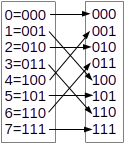
8.3.1. Remarks on the use of canned routines#
The detail use of the FFT package strongly depends on their implementation. It is important to read the manual carefully before using it. Numpy package includes FFT package numpy.fft, which is based on Cooley and Tukey algorithm[19] (See also Numerical Recipes[20].)
The most popular FFT package is FFTW[21] which earned J. H. Wilkinson Prize for Numerical Software in 1999. It is written in C language. A Python package PyFFTW is a wrapper to FFTW.
In this lecture, we use numpy.fft which have build-in functions fft for forward FFT and ifft for inverse FFT. However, as we discussed earlier the definition of “forward” and “inverse” is not unique. We need to find what they actually compute. In numpy fft computes
and ifft
Compare these definitions with Eqs (8.10), fft corresponds to our inverse Fourier transform and ifft to our forward Fourier transform. Notice also that neither fft or ifft has prefactor \(T\) or \(1/T\). we must multiply an appropriate prefactor by ourselves. Furthermore,
we must prepare the input data set \(\{f_m\}\) suitable for their application and converts output data \(\{F_k\}\) to a suitable form by reordering. Some key points we need to know are given below.
Forward or Backward Transformation
Apart from the factor \(T/N\) and \(1/T\), the difference between forward and backward transformation is the sign in the exponent. It is just the convention issue. FFTW, used \(\me^{-i\omega t}\) as forward, which is opposite to ours. My forward transformation may be your inverse transformation. We just have to use a routine which has a desired sign. Numpy use the same convention as FFTW.
Prefactor in front of the Summation
numpy.fft does not multiply \(T\) nor \(1/T\). It is up to us to multiply an appropriate prefactor. Note that the output of the fft and ifft does satisfy the Fourier theorem sin \(T \times 1/T = 1\).
Input/Output Format: Bit Reversed or Not
Most FFT routines carry out the bit reversal permutation internally. So, we don’t have to do it by ourselves. However, the order of output depends on the FFT routines. Some FFT routines return the results in the original order but others in the bit reversed order. Advanced packages allow the users to specify the output order. Why do we want the result in bit reversed order? In some cases, we repeat FFT many times but we need only the final output. Therefore, there is no need to change the order back and forth every time. If the bit-reversed order is kept during the repeated FFT, computing time is significantly saved. By default, ```numpy.fft`` returns the data in the regular order.
Input/Output format: Periodicity
Even when the output is not in the bit reversed order, the order of input/output data is often very confusing. Recall that we replaced \(\sum_{n=-N/2}^{N/2-1}\) with \(\sum_{n=0}^{N-1}\). FFT assumes that \(t=0, \Delta t, 2\Delta t, \cdots, (N-1)\Delta t\) and that the function values are stored in this order. There is no negative \(t\)!. Suppose that we have a function data \(f_n\) for \(n=0, \cdots, N-1\) with \(t_n = (n-N/2) \Delta t\). Although \(t\) begins with a negative value \(-N/2\), FFT doesn’t care about it and assume that the first data \(f_0\) is at \(t=0\). That is obviously wrong. Therefore, we need to change the order of the input data. Since the functions in DFT are periodic, we can add the period \(T\) to \(t\) without changing the function value. For \(t<0\), use \(\mathbf{f}(t+T)\). Now the function is evaluated at positive time only. In summary, the input data must be reordered as follows.
Similarly, the order of the output data is shifted in the same way as the input order. Usually, you want to get a function \(\tilde{f}(\omega)\) from \(-\Omega/2\) to \(\Omega/2\). The output from FFT is not like that. The first half of the data is for \(\omega = 0\) to \(\omega=\Omega/2\) and the latter half begins with \(\omega=-\Omega/2\) to \(\omega=-\Delta \omega\). The user must reordered the output before plotting it as following:
Numpy.fft provide functions fftshift and ifftshift to carryout the above transformation. The following example explains how to prepare the input data and recover the output you need.
Example 8.3.1 Foureir Transform of a Gaussian Function]
Let us compute the Fourier transform of a normalized Gaussian function
We shall call \(t\) time. The analytic solution is given by
where \(\omega\) is frequency. In this example, both \(f(t)\) and \(\tilde{f}(\omega)\) are real. This is due to the symmetry \(f(t)=f(-t)\).
First, we have to decide the parameter values. \(T=50\) and \(N=1024=2^{10}\) makes time resolution \(\Delta t \approx 0.05\) fine enough. The function value at the bound \(f(\pm T/2) \approx 10^{-272}\) seems unnecessarily too small. A smaller \(T\) could be used. However, the resolution of the frequency is \(\Delta \omega = 2\pi/T \approx 0.1\), barely small enough. Therefore, we cannot reduce \(T\).
A raw data set \(\mathbf{f}\) is created using a domain \(-T/2 < t < T/2\), which is plotted in Fig \ref{fig:fft_gaussian_order} (top left). Then, the lower half of the data is shifted by \(T\). In the program, we just swap the lower and upper half of the column vector. The resulting function is plotted in Fig \ref{fig:fft_gaussian_order} (bottom left). MATLAB’s function \texttt{ifft()} calculate our forward Fourier transform (\ref{eq:DFT_fwd2}). The raw output is plotted in Fig \ref{fig:fft_gaussian_order} (top right). The frequency domain is bounded by \(0\) and \(\Omega=2 \pi/T\), indicated by the dashed line. It is difficult to see the profile. Therefore, we swap the lower and upper half of the output array to get a normal plot for \(-\Omega/2 < \omega < \Omega/2\), which is plotted in Fig \ref{fig:fft_gaussian_order} (bottom right). It is still difficult to see the detail because the result is nearly zero for the most part. These zero regions are needed to keep the resolution of \(t\) small enough. Finally, we zoom into the important region. In Fig \ref{fig:fft_gaussian}, the final result and exact solution are compared. The agreement is nearly perfect.
First, we need to set up the range of \(t\) and the discrete time.
import numpy as np
# number of discrete time
N=1024
# Setting time domain
T=50. # size of time window
dt=T/N # time resolution
tmin=-T/2. # smallest time
tmax=tmin+dt*(N-1) # largest time
t0=np.linspace(tmin,tmax,N) # descete time series
Then, we constructe discrete frequency.
# continued from the previous code cell
# setting frequency domain
W=2.0*np.pi*N/T # size of the frequency domain
dw=W/N # frequency resolution
wmin=-W/2.0 # smallest frequency
wmax=wmin+dw*(N-1) # largest frequency
w0=np.linspace(wmin,wmax,N) # descrete frequency series
Let us look at the profile of input function.
# continued from the previous code cell
import matplotlib.pyplot as plt
# original Gaussian function in time domain
f0=np.exp(-t0**2)/np.sqrt(np.pi)
plt.figure(figsize=(4,4))
plt.plot(t0,f0,'-r',label=r'original function',linewidth=2)
plt.plot([-T/2,-T/2],[0,1],'--k')
plt.plot([T/2,T/2],[0,1],'--')
#plt.axis([-T/2*1.05, T*1.05, 0.0, 1.0])
plt.legend(loc=1)
plt.xlabel(r'$t$',fontsize=14)
plt.ylabel(r'$f(t)$',fontsize=14)
plt.show()
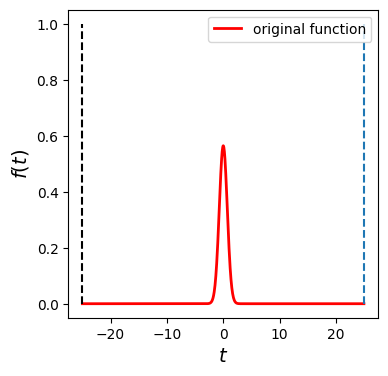
The function plotted above is not a suitable input for numpy.fft since time begins with negative value. Using the periodic propertiy of descrete fourier transform, we copy the left interval \(\[-T/2,0\]\) to the interval \(\[T/2,T\]\). We can use a function fft.fftishift to do it.
# construct shifted time domain
t1=np.linspace(0.0,dt*(N-1),N)
# shift the function
f1=np.fft.ifftshift(f0)
plt.figure(figsize=(4,4))
plt.plot(t1,f1,'-r',label=r'shifted function',linewidth=2)
plt.plot([0,0],[0,1],'--k')
plt.plot([T,T],[0,1],'--')
plt.legend(loc=1)
plt.xlabel(r'$t$',fontsize=14)
plt.ylabel(r'$f(t)$',fontsize=14)
plt.show()
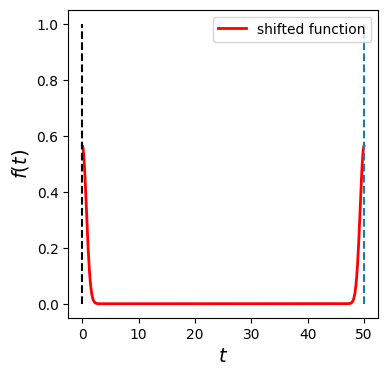
Now we are ready to compute fourier transform. Based on our convention, the transformation from the time domain to the frequecy domain corresponds to ifft in numpy. We need to multiple prefactor \(T\) to the output of ifft. The output is given in the frequency interval \(\[0,\Omega\]\). In general the output is given in complex. However, in the current example the result should be real. So, we plot only the real part of the output.
# shifted frequency domain
w1=np.linspace(0.0,dw*(N-1),N)
# FFT from time to frequency domain
g1=np.fft.ifft(f1)*T # do not forget to multiply T
plt.figure(figsize=(4,4))
# Fourier transform is complex in general even when input is real
# In the current example, the fourier transform is expected to be real.
plt.plot(w1,np.real(g1),'-r',label=r'raw output',linewidth=2)
plt.plot([0,0],[0,1],'--k')
plt.plot([W,W],[0,1],'--')
plt.legend(loc=1)
plt.ylim([0,1.3])
plt.xlabel(r'$t$',fontsize=14)
plt.ylabel(r'$f(t)$',fontsize=14)
plt.show()
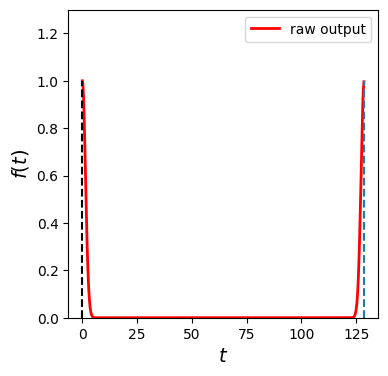
In order to compare the output with the analytic calculation, we need to shift back to the original frequency interval. That is to shift \(\[\Omega/2,\Omega\][\) to \(\[-\Omega/2,0\]\), which can be done with fft.ifftshift.
# Shift the output to the normal frequency domain
g0=np.fft.ifftshift(g1)
plt.figure(figsize=(4,4))
plt.plot(w0,np.real(g0),'-r',label=r'fourie transform',linewidth=2)
plt.plot([-W/2,-W/2],[0,1],'--k')
plt.plot([W/2,W/2],[0,1],'--')
plt.ylim([0,1.3])
plt.legend(loc=1)
plt.xlabel(r'$t$',fontsize=14)
plt.ylabel(r'$f(t)$',fontsize=14)
plt.show()
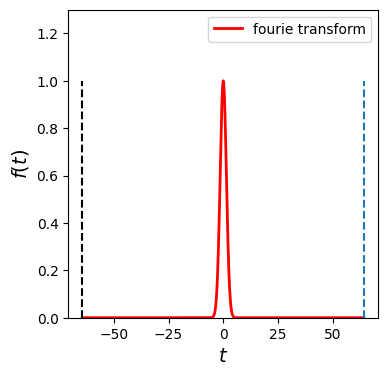
Finally we compare the result with the exact Fourier transform.
# exact Fourier transform
g2=np.exp((-w0**2)/4.0)
plt.figure(figsize=(4,4))
plt.plot(w0,g0,'-or',label='FFT',linewidth=2)
plt.plot(w0,np.real(g2),'-k',label='Exact',linewidth=2)
plt.xlim([-10,10])
plt.ylim([0,1.3])
plt.legend(loc=1)
plt.xlabel(r'$\omega$',fontsize=14)
plt.ylabel(r'$\tilde{f}(\omega)$',fontsize=14)
plt.show()
/home/kawai/anaconda3/envs/book/lib/python3.13/site-packages/matplotlib/cbook.py:1719: ComplexWarning: Casting complex values to real discards the imaginary part
return math.isfinite(val)
/home/kawai/anaconda3/envs/book/lib/python3.13/site-packages/matplotlib/cbook.py:1355: ComplexWarning: Casting complex values to real discards the imaginary part
return np.asarray(x, float)
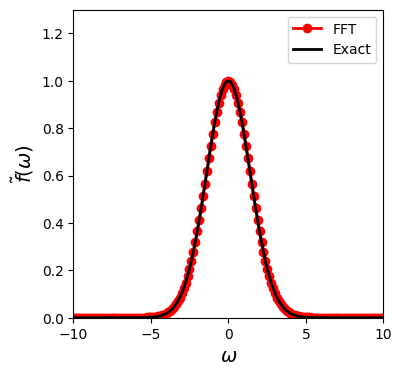
Tha agreement is pretty good.
Written on 9/25/2024 by Ryoichi Kawai.

